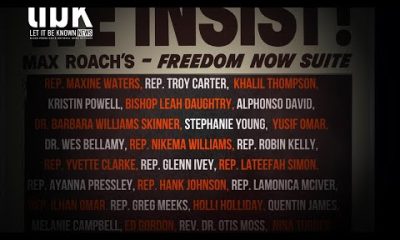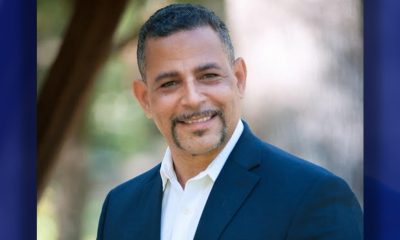#NNPA BlackPress
Md. Officials Map out School Construction Plans Based on Priority
WASHINGTON INFORMER — A work group composed of Maryland state, county and school officials met Thursday to assess and prioritize public school construction needs. Bob Gorrell, executive director of the state’s public school construction program, presented several recommendations on how to fund projects using a certain formula and a weight to calculate them based on need.
By William J. Ford
ANNAPOLIS — A work group composed of Maryland state, county and school officials met Thursday to assess and prioritize public school construction needs.
Bob Gorrell, executive director of the state’s public school construction program, presented several recommendations on how to fund projects using a certain formula and a weight to calculate them based on need.
To receive a high educational facility deficiency score, the math would be to add the facility condition index (physical condition of a school) with educational sufficiency number (usable school space) that would equal a combined deficiency score.
The higher the score, the higher a school project would be placed on a priority list of funding.
“I feel like we are in AP Calculus,” said Sen. Douglass J.J. Peters (D-District 23) of Bowie.
One simplified measure Peters and the nine-member group followed much easier stemmed from Gorrell’s proposed color-coded categories and weight scale based on highest priority and not per student population.
The number one classification would represent the highest priority for a school with immediate concerns such as mold, a sinking roof and electrical hazards.
Schools listed as number nine are schools recently in the less need built with new lighting, decent plumbing and not overcrowded.
“We are only talking about identifying the problem. The solution is a whole other discussion,” Gorrell said. “This is all considered works in progress.”
The proposal comes from how school districts in New Mexico organized school construction projects. Gorrell previously worked to lead that state’s construction efforts.
The population and government structures are slightly different between Maryland and New Mexico.
The 24 school districts in Maryland are organized in 23 counties and in Baltimore City. New Mexico has 89 school districts based in a certain region of the state.
Maryland county governments, such as Prince George’s, fund a significant portion of its budget toward public education.
In New Mexico, Gorrell said local school systems can receive state aid, but must mainly raise its own funds.
In theory, to implement the proposal in Maryland, Baltimore City could receive top priority for school construction because it has the most older school buildings in the state. Kent County ranks second and Prince George’s at third, according to the state’s Interagency Commission on School Construction.
“We should keep in mind how we do it in this state … [by] making sure each county gets its piece,” Del. Marc Korman (D-Montgomery County) said. “Our structure is by county.”
According to legislation for the Workgroup on the Assessment and Funding of School Facilities, a goal will be to provide at least $400 million each year for public school construction.
The legislature already approved millions of dollars for the next two fiscal years from the ongoing Kirwan Commission for mental health services, teacher salaries and other services.
State Superintendent Karen Salmon, who chairs the group, said more feedback will be obtained from local school facility planners and other officials.
“We’re just trying to make sure that we’ve got the right allocations so that if we do make any kind of comparisons, they make sense. I don’t think we’re at that point,” he said. “We have to make a decision because that’s part of our task.”
The group plans to meet at least four more times: Sept. 25, Oct. 7 and 28, Nov. 19. The goal would be to produce a final report by Dec. 1.
This post originally appeared in The Washington Informer.
#NNPA BlackPress
Remembering George Floyd
#NNPA BlackPress
OP-ED: Oregon Bill Threatens the Future of Black Owned Newspapers and Community Journalism
BLACKPRESSUSA NEWSWIRE — Nearly half of Oregon’s media outlets are now owned by national conglomerates with no lasting investment in local communities. According to an OPB analysis, Oregon has lost more than 90 news jobs (and counting) in the past five years. These were reporters, editors and photographers covering school boards, investigating corruption and telling community stories, until their jobs were cut by out-of-state corporations.

By Dr. Benjamin F. Chavis, Jr.
President and CEO, National Newspaper Publishers Association
For decades, The Skanner newspaper in Portland, the Portland Observer, and the Portland Medium have served Portland, Oregon’s Black community and others with a vital purpose: to inform, uplift and empower. But legislation now moving through the Oregon Legislature threatens these community news institutions—and others like them.
As President and CEO of the National Newspaper Publishers Association (NNPA), which represents more than 255 Black-owned media outlets across the United States—including historic publications like The Skanner, Portland Observer, and the Portland Medium—l believe that some Oregon lawmakers would do more harm than good for local journalism and community-owned publications they are hoping to protect.
Oregon Senate Bill 686 would require large digital platforms such as Google and Meta to pay for linking to news content. The goal is to bring desperately needed support to local newsrooms. However, the approach, while well-intentioned, puts smaller, community-based publications at a future severe financial risk.
We need to ask – will these payments paid by tech companies benefit the journalists and outlets that need them most? Nearly half of Oregon’s media outlets are now owned by national conglomerates with no lasting investment in local communities. According to an OPB analysis, Oregon has lost more than 90 news jobs (and counting) in the past five years. These were reporters, editors, and photographers covering school boards, investigating corruption, and telling community stories, until their jobs were cut by out-of-state corporations.
Legislation that sends money to these national conglomerate owners—without the right safeguards to protect independent and community-based outlets—rewards the forces that caused this inequitable crisis in the first place. A just and inclusive policy must guarantee that support flows to the front lines of local journalism and not to the boardrooms of large national media corporations.
The Black Press exists to fill in the gaps left by larger newsrooms. Our reporters are trusted messengers. Our outlets serve as forums for civic engagement, accountability and cultural pride. We also increasingly rely on our digital platforms to reach our audiences, especially younger generations—where they are.
We are fervently asking Oregon lawmakers to take a step back and engage in meaningful dialogue with those most affected: community publishers, small and independent outlets and the readers we serve. The Skanner, The Portland Observer, and The Portland Medium do not have national corporate parents or large investors. And they, like many smaller, community-trusted outlets, rely on traffic from search engines and social media to boost advertising revenue, drive subscriptions, and raise awareness.
Let’s work together to build a better future for Black-owned newspapers and community journalism that is fair, local,l and representative of all Oregonians.
Dr. Benjamin F. Chavis Jr., President & CEO, National Newspaper Publishers Association
#NNPA BlackPress
Hate and Chaos Rise in Trump’s America
BLACKPRESSUSA NEWSWIRE — Tactics ranged from local policy manipulation to threats of violence. The SPLC documented bomb threats at 60 polling places in Georgia, traced to Russian email domains.

By Stacy M. Brown
Black Press USA Senior National Correspondent
The Southern Poverty Law Center has identified 1,371 hate and antigovernment extremist groups operating across the United States in 2024. In its latest Year in Hate & Extremism report, the SPLC reveals how these groups are embedding themselves in politics and policymaking while targeting marginalized communities through intimidation, disinformation, and violence. “Extremists at all levels of government are using cruelty, chaos, and constant attacks on communities and our democracy to make us feel powerless,” said SPLC President Margaret Huang. The report outlines how hard-right groups aggressively targeted diversity, equity, and inclusion (DEI) initiatives throughout 2024. Figures on the far right falsely framed DEI as a threat to white Americans, with some branding it a form of “white genocide.” After the collapse of Baltimore’s Francis Scott Key Bridge, a former Utah legislator blamed the incident on DEI, posting “DEI = DIE.”
Tactics ranged from local policy manipulation to threats of violence. The SPLC documented bomb threats at 60 polling places in Georgia, traced to Russian email domains. Similar threats hit Jewish institutions and Planet Fitness locations after far-right social media accounts attacked them for trans-inclusive policies. Telegram, which SPLC describes as a hub for hate groups, helped extremists cross-recruit between neo-Nazi, QAnon, and white nationalist spaces. The platform’s lax moderation allowed groups like the Terrorgram Collective—designated terrorists by the U.S. State Department—to thrive. Militia movements were also reorganized, with 50 groups documented in 2024. Many, calling themselves “minutemen,” trained in paramilitary tactics while lobbying local governments for official recognition. These groups shared personnel and ideology with white nationalist organizations.
The manosphere continued to radicalize boys and young men. The Fresh & Fit podcast, now listed as a hate group, promoted misogyny while mocking and attacking Black women. Manosphere influencers used social media algorithms to drive youth toward male-supremacy content. Turning Point USA played a key role in pushing white nationalist rhetoric into mainstream politics. Its leader Charlie Kirk claimed native-born Americans are being replaced by immigrants, while the group advised on Project 2025 and organized Trump campaign events. “We know that these groups build their power by threatening violence, capturing political parties and government, and infesting the mainstream discourse with conspiracy theories,” said Rachel Carroll Rivas, interim director of the SPLC’s Intelligence Project. “By exposing the players, tactics, and code words of the hard right, we hope to dismantle their mythology and inspire people to fight back.”
Click here for the full report or visit http://www.splcenter.org/resources/guides/year-hate-extremism-2024.
-

 Activism4 weeks ago
Activism4 weeks agoAI Is Reshaping Black Healthcare: Promise, Peril, and the Push for Improved Results in California
-

 Activism4 weeks ago
Activism4 weeks agoBarbara Lee Accepts Victory With “Responsibility, Humility and Love”
-

 Activism4 weeks ago
Activism4 weeks agoESSAY: Technology and Medicine, a Primary Care Point of View
-

 Activism4 weeks ago
Activism4 weeks agoFaces Around the Bay: Author Karen Lewis Took the ‘Detour to Straight Street’
-

 Arts and Culture4 weeks ago
Arts and Culture4 weeks agoBOOK REVIEW: Love, Rita: An American Story of Sisterhood, Joy, Loss, and Legacy
-

 Activism4 weeks ago
Activism4 weeks agoNewsom Fights Back as AmeriCorps Shutdown Threatens Vital Services in Black Communities
-

 #NNPA BlackPress4 weeks ago
#NNPA BlackPress4 weeks agoThe RESISTANCE – FREEDOM NOW
-

 Activism4 weeks ago
Activism4 weeks agoTeachers’ Union Thanks Supt. Johnson-Trammell for Service to Schools and Community




















































